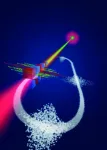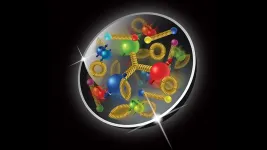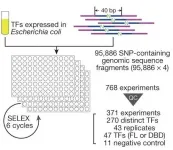Reactivating aging stem cells in the brain
2021-02-24
(Press-News.org) The stem cells in our brain generate new neurons throughout life, for example in the hippocampus. This region of the brain plays a key role for a range of memory processes. With increasing age, and in patients suffering from Alzheimer's disease, the hippocampus' ability to create new neurons declines steadily - and with it, its memory functions.
Distribution of age-dependent cell damage
A study conducted by the research group of Sebastian Jessberger, a professor at the Brain Research Institute of the University of Zurich, shows how the formation of new neurons is impaired with advancing age. Protein structures in the nuclei of neural stem cells make sure that harmful proteins accumulating over time are unevenly distributed onto the two daughter cells during cell division. This seems to be an important part of the cells' ability to proliferate over a long time in order to maintain the supply of neurons. With advancing age, however, the amounts of nucleic proteins change, resulting in defective distribution of harmful proteins between the two daughter cells. This results in a decrease in the numbers of newly generated neurons in the brains of older mice.
The central element in this process is a nuclear protein called lamin B1, the levels of which decrease as people age. When the researchers increased lamin B1 levels in experiments in aging mice, stem cell division improved and the number of new neurons grew. "As we get older, stem cells throughout the body gradually lose their ability to proliferate. Using genetic engineering and cutting-edge microscope technology, we were able to identify a mechanism that is associated with this process," says doctoral candidate and first author Khadeesh bin Imtiaz.
Halting the aging process of stem cells
The research is part of several ongoing projects aiming to reactivate aging stem cells. The ability to regenerate damaged tissue generally declines with age, thus affecting almost all types of stem cells in the body. "While our study was limited to brain stem cells, similar mechanisms are likely to play a key role when it comes to the aging process of other stem cells," says Sebastian Jessberger.
These latest findings are an important step towards exploring age-dependent changes in the behavior of stem cells. "We now know that we can reactivate aging stem cells in the brain. Our hope is that these findings will one day help increase levels of neurogenesis, for example in older people or those suffering from degenerative diseases such as Alzheimer's. Even if this may still be many years in the future," says Jessberger.
INFORMATION:
[Attachments] See images for this press release:

ELSE PRESS RELEASES FROM THIS DATE:
2021-02-24
The most modern light sources for research are based on particle accelerators. These are large facilities in which electrons are accelerated to almost the speed of light, and then emit light pulses of a special character. In storage-ring-based synchrotron radiation sources, the electron bunches travel in the ring for billions of revolutions, then generate a rapid succession of very bright light pulses in the deflecting magnets. In contrast, the electron bunches in free-electron lasers (FELs) are accelerated linearly and then emit a single super-bright flash of ...
2021-02-24
Researchers have mapped the physical organization of the brain of a microscopic soil-living nematode worm called Caenorhabditis elegans, creating a new model for the architecture of the animal's brain and how it processes information.
In a surprise twist, they found a large degree of variation in the structure of some neural circuits or pathways in individual worms which complemented a core set of neural circuits common to different animals.
The scientists say the worms' brains might have a lot more in common with larger animals than previously thought.
Created by neuroscientists at the University of Leeds in collaboration with researchers in New York's Albert Einstein College of Medicine, the brain map reveals that ...
2021-02-24
Scientists at the Children's Medical Center Research Institute at UT Southwestern (CRI) have identified the specialized environment, known as a niche, in the bone marrow where new bone and immune cells are produced. The study, published in Nature, also shows that movement-induced stimulation is required for the maintenance of this niche, as well as the bone and immune-forming cells that it contains. Together, these findings identify a new way that exercise strengthens bones and immune function.
Researchers from the Morrison laboratory discovered that forces created from walking or running are transmitted from bone surfaces along arteriolar blood vessels into the marrow inside bones. Bone-forming ...
2021-02-24
A study of spatial learning in mice shows that exposure to new experiences dampens established representations in the brain's hippocampus and prefrontal cortex, allowing the mice to learn new navigation strategies. The study, published in Nature, was supported by the National Institutes of Health.
"The ability to flexibly learn in new situations makes it possible to adapt to an ever-changing world," noted Joshua A. Gordon, M.D., Ph.D., a senior author on the study and director of the National Institute of Mental Health, part of NIH. "Understanding the neural basis of this flexible learning in animals gives us insight into ...
2021-02-24
Asymmetry in the proton confounds physicists, but a new discovery may bring back old theories to explain it.
Symmetry -- displayed in areas ranging from mathematics and art, to living organisms and galaxies -- is an important underlying structure in nature. It characterizes our universe and enables it to be studied and understood.
Because symmetry is such a pervasive theme in nature, physicists are especially intrigued when an object seems like it should be symmetric, but it isn't. When scientists are confronted with these broken symmetries, it's as if they've found an object with a strange reflection in the mirror.
"Nature is leading the way for concepts in older models of the proton to get a second look." -- ...
2021-02-24
UCLA materials scientists and their colleagues have developed a new method to make synthetic biomaterials that mimic the internal structure, stretchiness, strength and durability of tendons and other biological tissues.
The researchers developed a two-pronged process to enhance the strength of existing hydrogels that could be used to create artificial tendons, ligaments, cartilage that are 10 times tougher than the natural tissues. Although the hydrogels contain mostly water with little solid content (about 10% polymer), they are more durable than Kevlar and rubber, which are both 100% polymer. This kind of breakthrough has never been achieved in water-laden polymers until this study, which was recently published in Nature. ...
2021-02-24
With the hope of contributing to the fight against cancer, researchers in Sweden have published a new molecular mapping of proteins that regulate the cell division process - identifying 300 such proteins.
The release of the data, which was published today in the scientific journal, Nature, is significant because it helps bring medical research closer to the point of being able to target specific proteins to treat cancer.
Identifying and understanding what characterizes these proteins is important, says co-author Emma Lundberg, a professor at KTH Royal Institute of Technology whose research group at Science ...
2021-02-24
What The Study Did: National COVID-19 registry data are used in this study to describe the epidemiology, clinical characteristics, complications, and hospital and postdischarge outcomes of pediatric patients with multisystem inflammatory syndrome in children (MIS-C) and to compare each in patients with severe COVID-19.
Authors: Adrienne G. Randolph, M.D., of Boston Children's Hospital, is the corresponding author.
To access the embargoed study: Visit our For The Media website at this link https://media.jamanetwork.com/
(doi:10.1001/jama.2021.2091)
Editor's Note: The article includes conflict of ...
2021-02-24
What The Study Did: This randomized clinical trial compares the effects of once-weekly subcutaneous semaglutide versussplacebo for weight management as an adjunct to intensive behavioral therapy with initial low-calorie diet in adults with overweight or obesity.
Authors: Thomas A. Wadden, Ph.D., of the University of Pennsylvania in Philadelphia, is the corresponding author.
To access the embargoed study: Visit our For The Media website at this link https://media.jamanetwork.com/
(doi:10.1001/jama.2021.1831)
Editor's Note: The article includes conflict of interest and funding/support disclosures. Please see the article for additional information, including other authors, author contributions ...
2021-02-24
Many genetic variants have been found to have a linkage with genetic diseases, but the understanding of their functional roles in causing diseases are still limited. An international research team, including a biomedical scientist from City University of Hong Kong (CityU), has developed a high-throughput biological assay technique which enabled them to conduct a systematic analysis on the impact of nearly 100,000 genetic variants on the binding of transcription factors to DNA. Their findings provided valuable data for finding key biomarkers of type 2 diabetes for diagnostics and treatments. And they ...
LAST 30 PRESS RELEASES:
[Press-News.org] Reactivating aging stem cells in the brain






